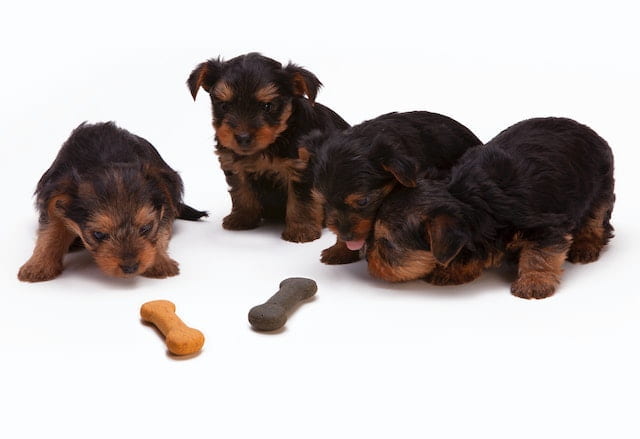There are many things to consider when it comes to why puppies eat their poop. Some of these issues include a dietary deficiency, an illness or an anxiety problem. Other conditions include intestinal parasites.
Anxiety
When your dog starts eating his poop, you may wonder why. After all, it’s disgusting and oftentimes annoying behavior. Fortunately, there are a number of ways to deal with it.
One of the first things you should do is get your dog checked out by a vet. There are a variety of medical conditions that can cause dogs to eat their poop. These include intestinal parasites, liver disease, and nutritional deficiencies.
Another reason for a dog’s poop eating habit is anxiety. It’s not uncommon for puppies to eat poop when they are anxious. Especially if they are confined, such as in a crate, they will become stressed by the punishment and will eat the poop to alleviate the stress.
Poop eating is not something you want to encourage. Instead, focus on training and rewards. Small treats are often effective, as they help to reinforce the good behaviors of your dog.
If you do have an anxious puppy, a calming pill such as Adaptil can help. Alternatively, you can play interactive toys to keep him occupied. However, you need to take care not to overdo it.
Dietary deficiency
If your dog is eating feces, you should seek medical attention. The dog may have an intestinal parasite or malabsorption syndrome. Depending on the cause, it is important to determine if it is necessary to take antibiotics or other treatments.
Some experts believe that coprophagy in dogs is caused by an inability to digest their food. Dogs who are under constant stress or have a gastrointestinal disorder will also be more likely to eat poop.
Other causes of coprophagia include a deficiency in vitamin B, which is responsible for maintaining proper digestion. If your dog is eating poop, you can try adding a supplement of vitamin B to his diet.
Aside from a nutritional deficiency, other conditions that may lead to poop eating include hypothyroidism, diabetes, and Cushing’s disease. In addition, there are some drugs that can make a dog feel hungry.
Puppies and adult dogs may also eat stools if they are not absorbing the nutrients they need from their diet. It can be a sign of a gastrointestinal disease, such as EPI (Eosinophilic esophagitis).
It can be difficult to diagnose coprophagy. A vet can perform diagnostic tests to determine the underlying condition. Once a diagnosis has been made, your vet can provide you with guidance on a good diet for your pet.
>>> You may like this: How to Build a Dog Food Storage Bin?
Illness

If you have a dog, you may have noticed that he or she often eats their poop. This is a common behavior and can cause health problems in some dogs. Fortunately, there are things you can do to stop this unwanted habit.
One reason a dog may eat poop is due to a lack of vitamin intake. Poorly digested food can also lead to this undesirable behavior.
Other causes of stool eating in adult dogs include maldigestion, intestinal parasites, or diseases of the pancreas. It’s best to get your dog checked out by a veterinarian. A fecal sample can tell you whether or not your dog has a parasite infection.
Some veterinarians think that a dog may be trying to ingest nutrients from his or her feces. However, this is rarely the case. Instead, it’s more likely that your dog is attempting to eat a mixture of undigested food and feces.
Another possible explanation is that your dog is seeking out a source of nutrients from the remnants of food. This is commonly seen in puppies, and it can happen even in adults.
Trying to figure out what the best dog food is for your pup? Check out our blog for a comprehensive guide to finding the right food for your furry friend.
Intestinal parasites
Intestinal parasites can be a problem for pets. This is because they can be carriers of disease. These parasites can affect dogs, cats, and even humans. They can be transmitted through various means, including through fecal matter, soil, contaminated water, or by flea bites. If left untreated, these infections can be very dangerous.
The most common type of intestinal parasites are roundworms, hookworms, and tapeworms. All of these parasites can cause serious health problems in animals. Dogs can be infected by these parasites, especially puppies.
Puppies can get infected by drinking contaminated milk from their mother. They can also be infected by eating feces from infected animals. It is important for puppies to avoid these worms.
When puppies are younger, they are more prone to getting infected with intestinal parasites. It is important to make sure that their diets are filled with nutrients.
Intestinal parasites can cause dogs to lose weight, develop diarrhea, and experience other gastrointestinal issues. The condition can also lead to other health complications. A veterinarian can diagnose these illnesses through a fecal examination.
See more: https://telegra.ph/How-to-Make-Dog-Food-Storage-Container-Look-Better-01-12



